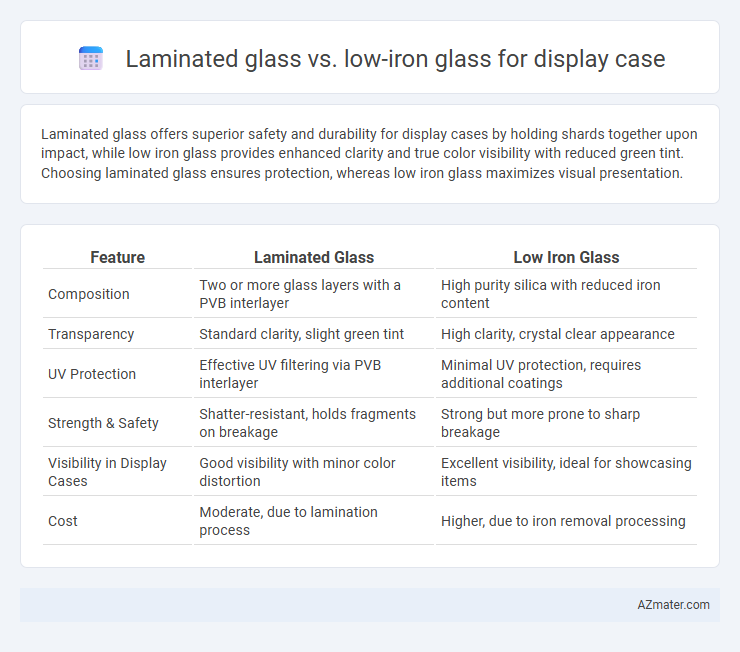Laminated glass offers superior safety and durability for display cases by holding shards together upon impact, while low iron glass provides enhanced clarity and true color visibility with reduced green tint. Choosing laminated glass ensures protection, whereas low iron glass maximizes visual presentation.
Table of Comparison
| Feature | Laminated Glass | Low Iron Glass |
|---|---|---|
| Composition | Two or more glass layers with a PVB interlayer | High purity silica with reduced iron content |
| Transparency | Standard clarity, slight green tint | High clarity, crystal clear appearance |
| UV Protection | Effective UV filtering via PVB interlayer | Minimal UV protection, requires additional coatings |
| Strength & Safety | Shatter-resistant, holds fragments on breakage | Strong but more prone to sharp breakage |
| Visibility in Display Cases | Good visibility with minor color distortion | Excellent visibility, ideal for showcasing items |
| Cost | Moderate, due to lamination process | Higher, due to iron removal processing |
Introduction to Laminated Glass and Low Iron Glass
Laminated glass consists of two or more glass layers bonded with an interlayer, providing enhanced safety, impact resistance, and UV protection, making it ideal for secure display cases. Low iron glass is specially formulated to reduce greenish tint, delivering superior clarity and true color representation for showcasing valuable items. Both materials serve distinct purposes in display cases, with laminated glass prioritizing safety and durability, while low iron glass emphasizes visual purity and brightness.
Key Properties of Laminated Glass
Laminated glass for display cases offers exceptional safety and durability due to its interlayer that holds shards together upon impact, reducing injury risk and protecting contents. It provides high acoustic insulation and enhanced UV resistance, preserving displayed items from fading and damage. Its structural integrity and resistance to breakage make laminated glass a preferred choice for secure and long-lasting display cases.
Key Properties of Low Iron Glass
Low iron glass offers exceptional clarity and high light transmission up to 91.5%, making it ideal for display cases that require true color representation and minimal green tint compared to standard laminated glass. Its superior optical purity enhances product visibility, while its increased strength and UV resistance protect exhibits effectively. Low iron glass is preferred in high-end display cases where both aesthetics and durability are critical performance factors.
Visual Clarity and Color Accuracy Comparison
Laminated glass in display cases offers enhanced safety through bonded layers but can slightly reduce visual clarity due to interlayer reflections, which may affect color accuracy. Low iron glass provides superior optical clarity and true-to-life color rendition by minimizing the green tint found in standard glass, making it ideal for high-fidelity displays. Choosing low iron glass significantly improves color accuracy and visual sharpness, critical for showcasing art or retail products where precise color representation is essential.
Strength and Safety Considerations
Laminated glass consists of two or more glass layers bonded with an interlayer, providing superior impact resistance and preventing shard dispersion upon breakage, making it ideal for safety in display cases. Low iron glass offers enhanced clarity and color neutrality but lacks the inherent strength and safety properties of laminated glass, making it more prone to shattering. For display cases requiring high durability and protection, laminated glass is the preferred choice due to its ability to maintain structural integrity and protect contents from accidental damage.
UV Protection and Light Transmission
Laminated glass offers superior UV protection for display cases, blocking up to 99% of harmful ultraviolet rays, which helps preserve sensitive artifacts and materials. Low iron glass enhances light transmission, providing up to 91-92% clarity, resulting in brighter and clearer displays with minimal color distortion. For optimal preservation and visual impact in display cases, combining laminated glass with low iron properties ensures maximum UV blocking and high transparency.
Durability and Maintenance Requirements
Laminated glass offers superior durability for display cases due to its multi-layered construction, which holds shards together upon impact, reducing breakage risk and enhancing safety. Low iron glass, while providing higher clarity and a more transparent appearance, is less resistant to impact and scratches compared to laminated glass. Maintenance of laminated glass is easier since minor cracks do not compromise the entire pane, whereas low iron glass requires careful handling and frequent cleaning to preserve its pristine look and prevent visible damage.
Cost Analysis: Laminated vs Low Iron Glass
Laminated glass for display cases generally offers enhanced safety and durability but comes at a higher production cost compared to low iron glass, which prioritizes clarity and aesthetic appeal with a moderate price increase over standard glass. Low iron glass can have increased upfront costs due to its refined manufacturing process, but laminated glass's additional layers and adhesive films contribute to more significant expenses, especially in thicker or larger panels. When balancing cost with function, laminated glass provides superior impact resistance and UV protection, while low iron glass emphasizes visual purity and brightness, affecting the total investment depending on specific display needs.
Best Use Cases for Display Cases
Laminated glass offers superior safety and security for display cases in high-traffic areas or locations susceptible to impact or vandalism, making it ideal for museums and retail environments. Low iron glass provides enhanced clarity and true color representation, perfect for showcasing valuable or colorful artifacts where visual aesthetics are paramount. Combining laminated low iron glass can deliver both protection and optimal clarity, suitable for premium display cases in galleries or luxury stores.
Final Recommendation: Choosing the Right Glass for Your Display Case
Laminated glass offers enhanced safety and security due to its interlayer that holds shards together upon impact, making it ideal for high-traffic or vulnerable display cases. Low iron glass provides superior clarity and color accuracy, perfect for showcasing valuable or detailed items where visual excellence is crucial. For display cases requiring both protection and optimal visibility, a combination of laminated low iron glass delivers the best balance of durability and aesthetic appeal.

Infographic: Laminated glass vs Low iron glass for Display case
 azmater.com
azmater.com